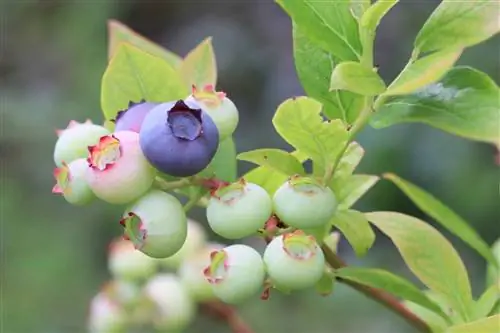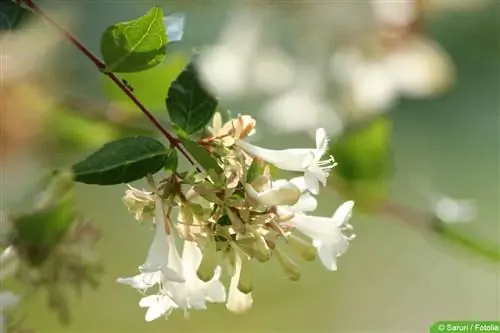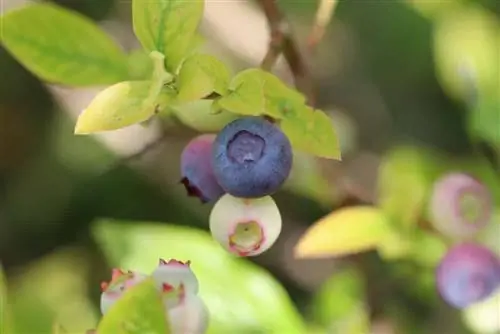- Author admin [email protected].
- Public 2023-12-17 03:39.
- Last modified 2025-01-24 12:45.
Cultivated blueberries do not come from the blueberries that are often found in the forests here, but from blueberry varieties from North America. You don't have to expect that your tongue, teeth and hands will be blue after eating them, because in these varieties the blue dye is only in the fruit peel.
Care for cultivated blueberries
Cultivated blueberries can be planted either directly in the garden or in a container. They are relatively easy to care for, but require sufficient water during flowering and fruit formation because their shallow roots make it difficult for them to take care of themselves. Watering should therefore be carried out regularly at these times. However, blueberries are sensitive to lime, so it is recommended to only use rainwater. To prevent the soil from drying out too quickly in summer, a layer of mulch around the plants is helpful.
Cultivated blueberries place special demands on the soil. It must be acidic and have a low pH value. In most gardens the natural pH value is too high for these plants, so the soil usually needs to be amended with peat or ericaceous soil. A soil with a pH value between 4 and 5 is ideal for blueberries.
The best location is a sunny and wind-protected place. If several plants are to be planted, a distance of one to two meters is required. When planting, make sure that the roots are only lightly covered with soil, because the entire plant suffers if the roots do not receive enough oxygen and then only produces a few flowers and fruits. Depending on the variety, a blueberry can grow up to two meters high, so you need to plan for enough space in this regard too.
Cutting and propagating
Pruning the cultivated blueberries is only necessary after four to five years. The oldest branch should then be removed once a year to promote the formation of new shoots. Otherwise, only branches that are diseased or that are too close together are cut off so that all the berries get enough sun to ripen.
Cultivated blueberries can be easily propagated using planters. This involves bending a shoot of an existing plant down to the ground, cutting it slightly and then fixing it in the ground with a wire hanger or a stone. This shoot soon forms its own roots in the soil, but until then it is still supplied with water and nutrients by the mother plant. After a few months it can then be separated and transplanted to the desired location. It is best to put a sinker into the ground in the fall so that it can be transplanted the following spring.
Varieties & their care
Cultivated blueberries are a good alternative to wild blueberries. They grow larger, are easy to harvest and taste good. However, they do not come from our wild blueberries, but from North American varieties. Cultivated blueberries are quite easy to grow in the garden. Then they have another plus, their beautiful autumn color. You can harvest up to 8 kilograms of fruit from one blueberry bush.
Recommended varieties
- Blueberry 'Sunshine Blue' - half-high shrub, about 1 meter, harvest from July to August, fruits very sweet, very large, evergreen plant with blue-green foliage, pink flowers, high ornamental value
- Blueberry 'Reka' - tall bush, 1.70 to 2 meters, harvest from the beginning of July, several weeks, fruits medium-sized but particularly aromatic, bright red autumn color, pruning required from the 5th year onwards
- Blueberry 'Bluecrop' - tall shrub, 1.60 to 2 meters, harvest from the beginning of August, fruits large, firm and with a very good taste, also suitable for extreme locations, high yields, good ornamental value
- Blueberry 'Bluetta' - low and compact growth, harvest from the beginning of July, fruits small but very aromatic, abundant harvests right from the start, not suitable for locations prone to late frost
- Blueberry 'Brigitta Blue' - tall bush, 1.80 to 2 meters, harvest late, from mid-August, medium-sized fruits, crunchy, sweet and sour, berries store well, high ornamental value
- Red blueberries 'Red Winner' - red-fruited variety, tall bush, up to 2 meters, harvest from July, several weeks, until autumn, taste like currants, requires light, humus-rich soil
Location
The location must be in full sun.
Planting substrate
It is good if the soil is slightly acidic. The ideal pH value is between 3.5 and 5. The planting pit is dug about 80 cm deep and filled with acidic substrate, e.g. ericaceous or rhododendron soil. Since cultivated blueberries do not like lime, the plants should be protected from below with a plastic film. It is placed in the empty planting hole. This prevents groundwater or seepage water that rises from reaching the roots. Holes in the film are important. They serve for drainage.
Plants
The planting distance should be 80 to 100 cm. Plant the bales so deep that they are covered with 3 to 5 cm of soil. It is recommended to cover the soil with bark mulch. It is beneficial to add Mykorrizha mushroom substrate, a natural fungus that can be found in forest soil, to the soil directly when planting. This increases the resistance of the plants and increases the yield.
Watering and fertilizing
Watering only with lime-free water. In hot summers, watering must be abundant. Cultivated blueberries have shallow roots and the roots dry out quickly. Even during flowering, the plants must not dry out. Fertilize with acidic fertilizer, e.g. for rhododendrons.
Cutting cultivated blueberries
If you want to harvest plenty of blueberries, you should cut back the bushes a little annually. Aged, gnarled and too dense branch areas are removed. It is also a good idea to cut away worn fruit wood that only has small, poorly ripened berries on it. A cut promotes the formation of young shoots and is the prerequisite for good yields.
Bird protection
Birds are crazy about blueberries. It is best to cover the plants with nets. Coarse-meshed, thick-threaded nets are ideal. If a bird gets caught in it, it can easily be freed.
Blueberries in planters
- Dwarf varieties are suitable for keeping in containers. They only grow to a height of around 50 cm.
- Most varieties are frost hardy and bear fruit from the 3rd year onwards.
- The plants prefer a partially shaded location and also acidic soil.
- Good varieties are: `Dixi`, `Coville`, `Jersey`, `Top Hat`, `Berkeley`, `Ama`, `Heerma` and `Spartan`.
Tip:
In order to get a high fruit set, you should combine different varieties with each other. This is how cross-pollination simply works better.






